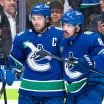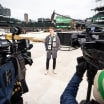The Coaches Room is a regular feature throughout the 2024-25 season by former NHL coaches and assistants who turn their critical gaze to the game and explain it through the lens of a teacher.
In this edition, Craig Johnson, a former assistant with the Anaheim Ducks and Ontario of the American Hockey League and development coach with Los Angeles Kings, writes how load management can help young players at the start of their NHL careers.
Load management, or resting players for certain games, has become a topic of much discussion in the NBA. It’s not as common in the NHL, but in recent seasons it’s become a tool for helping young players at the start of their careers.
I was an assistant with the Anaheim Ducks last season when they utilized load management with rookie forward Leo Carlsson, the No. 2 pick in the 2023 NHL Draft. The San Jose Sharks have taken a similar approach with rookie forward Will Smith, the No. 4 pick in the 2023 draft, this season.
Carlsson came into the NHL as an 18-year-old after playing in the Swedish Hockey League the previous season. They don’t play as many games in that league as in the NHL, playing more on the weekends and not as much during the week, so young players have time off between games to rest and develop. Going from that to a much-busier, 82-game schedule in the NHL can be a significant jump.
As coaches, you never want to see a player like Carlsson sit out. That’s the No. 1 thing. It’s a tough message to sell with a player that you’re trying to win when you’re sitting one of your best players out.
But for the benefit of the young player in the long run, sitting out certain games gives him time to go into the gym, so he’s able to work out and get stronger. He’s able to manage his rest too, so he can come into games a little bit fresher and stronger.
The Ducks sports performance department put together a load management plan for Carlsson where they determined the number of games that would be best for him while also looking at the schedule and seeing where he could get in two or three good lifts in the weight room.
When the players come into training camp, they are tested in specific areas such as flexibility, strength, power and other areas where they may have weaknesses. Carlsson is such a talented hockey player. He has skill, he has vision, he has size, all those things, but he didn’t have the biggest legs when he came in. So, putting a little bit more muscle on those legs through work in the weight room was important.


















